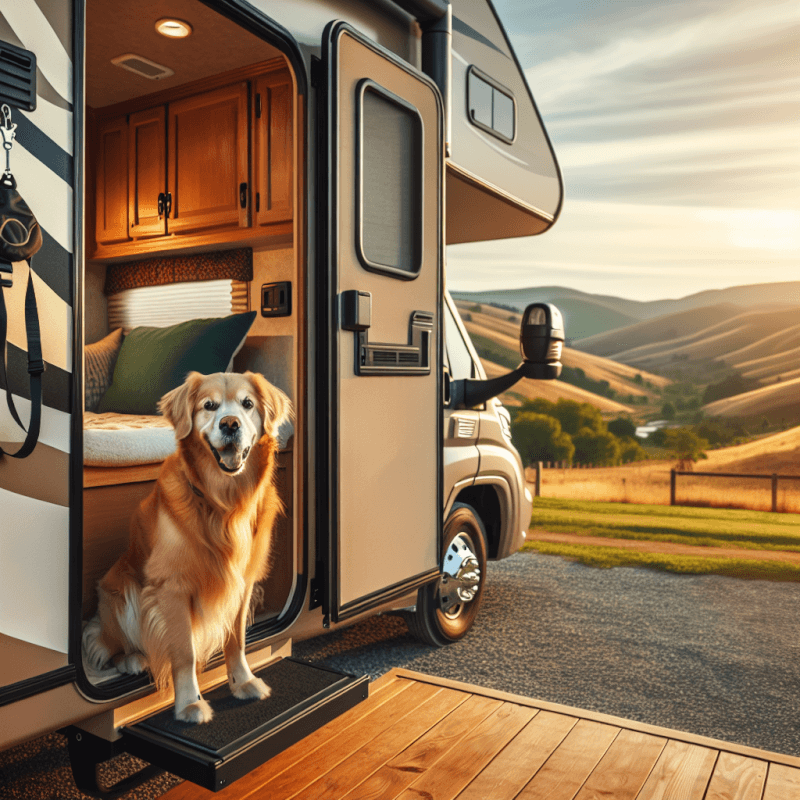Traveling with your pets in an RV can be a fun and rewarding experience, but it also requires careful planning and consideration. From ensuring their safety and comfort to finding pet-friendly destinations, there are several factors to keep in mind. In this article, we will explore some essential tips and guidelines to make your journey with your furry friends an enjoyable one. So, if you’re thinking about hitting the road with your pets in an RV, read on to discover how you can make the most out of this adventure while keeping your pets happy and healthy.

Choosing the Right RV
When it comes to traveling with pets in an RV, choosing the right vehicle is crucial. Size and layout are important factors to consider. You want to ensure there is enough space for your pet to move around comfortably. Larger breeds may require more room to stretch their legs, so opt for an RV with a spacious interior. Additionally, consider the layout of the RV. Will your pet have a designated sleeping area or a spot to eat their meals? Look for RVs that provide separate areas for your pet to relax and enjoy their own space.
Safety features are another key consideration. Make sure the RV is equipped with safety features such as seatbelts or harness attachments to keep your pet secure while on the road. Look for RVs that have a reinforced screen door or safety gates to prevent your pet from accidentally escaping when you open the door. It’s also a good idea to choose an RV with proper ventilation to ensure your pet has fresh air during the journey.
Lastly, select an RV with pet-friendly amenities. Look for RVs that have easy-to-clean floors, such as laminate or vinyl, to make cleaning up after your pet a breeze. Consider RVs that offer built-in pet dishes or easy access to a water source. Some RVs even have specific pet washing stations, which can be very convenient when your furry friend needs a bath after a day of outdoor activities.
Preparing Your Pet for the Trip
Before hitting the road, it’s essential to prepare your pet for the upcoming adventure. Start by scheduling a health check-up with your veterinarian. Ensure that your pet is up-to-date on vaccinations and in good overall health. Your veterinarian can also provide any necessary medications or preventatives for the trip, such as flea and tick protection.
Microchipping and ID tags are crucial for the safety of your pet. In case they accidentally get lost, having identification can help ensure a quick reunion. Make sure your pet’s microchip information is updated with your current contact details. Additionally, attach identification tags to your pet’s collar with your phone number and any relevant medical information.
Pack familiar items for your pet to keep them comfortable and ease any anxiety they may experience during the trip. Bring their favorite bedding, toys, and even a piece of clothing with your scent to provide a sense of familiarity. This will help create a secure and comforting environment for your pet in the RV.
If your pet is not used to traveling in a vehicle, it’s important to help them adjust through car training. Start by taking them on short car rides to gradually acclimate them to the motion and sights. Bring along treats and toys to make the experience positive and rewarding. Over time, your pet will become more comfortable with car travel, making the RV journey more enjoyable for both of you.

Ensuring Pet-Friendly Campsites
Finding pet-friendly campsites is a crucial part of traveling with pets in an RV. Before your trip, thoroughly research the pet policies of the campsites you plan to visit. Some campsites may have restrictions on certain breeds or require specific vaccinations for pets. Ensure that the campsites you choose are truly pet-friendly and will welcome your furry companions with open arms.
Consider the amenities available for pets at each campsite. Look for campsites that offer designated pet areas or dog parks where your pet can socialize and exercise. Some campsites even provide pet-friendly hiking trails or swimming areas, which can make your pet’s outdoor experience even more enjoyable. It’s also a good idea to check if the campsites have pet waste disposal stations to make clean-up hassle-free.
Keep in mind that leash and waste regulations may vary from campsite to campsite. Make sure you are aware of the specific rules and adhere to them at all times. Keep your pet on a leash whenever required and always clean up after them. By respecting these regulations, you contribute to maintaining a clean and safe environment for everyone at the campsite.
Securing a Safe Space for Your Pet
Creating a safe space for your pet inside the RV is essential for their well-being. Consider different restraining methods to ensure your pet stays secure while the vehicle is in motion. Harnesses or pet seatbelts can be used to keep them restrained and prevent any accidents. Some RVs even have built-in crates or kennels that provide a designated, secure space for your pet during travel.
Within the RV, it’s important to create a comfortable area for your pet to relax. Set up their bedding and familiar items in a quiet corner where they can rest and feel safe. Provide them with a cozy space to retreat to when they need some downtime. Additionally, consider using baby gates or barriers to prevent your pet from accessing certain areas of the RV that may be unsafe or contain potentially harmful items.
Temperature control is crucial for your pet’s well-being. Ensure that the RV has proper ventilation or air conditioning to maintain a comfortable temperature inside. Avoid leaving your pet alone in the RV without adequate temperature control, especially during extreme weather conditions. If necessary, consider using fans or portable heaters to ensure a comfortable environment for your furry friend.

Feeding and Hydration
Proper nutrition and hydration are important for your pet’s health and well-being during the RV trip. Choose pet-friendly food that is suitable for their specific dietary needs. Look for options that are easy to store and serve in the limited space of an RV kitchen. Consider portion control to prevent overfeeding, as travel may require less physical activity than your pet is accustomed to.
Establish a regular feeding schedule for your pet to maintain routine and prevent stomach upset. Stick to their usual mealtimes as closely as possible, allowing for any time zone changes during the journey. Avoid feeding your pet immediately before travel to prevent car sickness. Instead, offer them a light meal a few hours before hitting the road.
Ensure that your pet has access to clean and fresh water throughout the journey. Pack enough water for the duration of your trip, taking into account any uncertainties in finding reliable water sources along the way. Portable water bowls or dispensers are convenient solutions for providing hydration to your pet during travel and at the campsites.
Exercise and Entertainment
While traveling in an RV, it’s important to provide your pet with regular exercise and entertainment. Designate specific time for exercise during stops or at pet-friendly campsites. Take your pet for walks or hikes to allow them to stretch their legs and explore their surroundings. Remember to keep them on a leash when required and follow any trail regulations.
Research pet-friendly activities in the areas you plan to visit. Look for dog-friendly beaches, parks, or hiking trails where your pet can enjoy some off-leash freedom. Some campgrounds even offer organized pet activities or events that can provide socialization and entertainment for your furry friend. Engaging in these activities will ensure that your pet stays physically and mentally stimulated throughout the journey.
Bring along plenty of toys and games to keep your pet occupied during downtime in the RV. Interactive toys, puzzle toys, and chew toys can help prevent boredom and destructive behavior. Playing games like fetch or tug-of-war inside or outside the RV can also provide valuable exercise and bonding time with your pet.

Managing Pet Waste
Proper waste disposal is essential when traveling with pets in an RV. Always clean up after your pet, whether you are at a campsite or on a hike. Carry waste disposal bags with you at all times to ensure that you can easily pick up and dispose of any waste. Avoid leaving waste behind, as it can negatively impact the environment and the experiences of other campers.
Pack enough clean-up supplies, such as paper towels and pet-safe cleaning products, to effectively deal with any accidents or spills inside the RV. Promptly clean any messes to prevent odor and maintain a sanitary environment. Consider using pet-friendly cleaning products to avoid any harmful chemicals coming in contact with your pet or their paws.
To avoid contamination, always dispose of pet waste properly. Many campgrounds provide designated pet waste disposal stations, with bags and bins specifically for this purpose. Use these stations whenever available. If no designated stations are provided, dispose of the waste in sealed bags in appropriate trash receptacles, following any specific instructions given by the campground or local authorities.
Emergency Preparedness for Pets
Being prepared for emergencies is vital when traveling with pets in an RV. Carry a list of veterinary and emergency contact information for the areas you plan to visit. This includes the contact details of local veterinarians, emergency animal hospitals, and poison control centers. Keep this information easily accessible, both digitally and in hard copy, in case of any unforeseen situations.
Put together a pet first aid kit to have on hand during the trip. The kit should include basic items such as bandages, antiseptic solutions, tweezers, and any necessary medications for your specific pet. Familiarize yourself with basic first aid techniques for pets, such as CPR and wound care, before embarking on the journey. Knowing how to respond in an emergency can make all the difference for your pet’s well-being.
Understand the local veterinary services available along your route. Research the locations and hours of veterinary clinics or hospitals in case your pet requires immediate medical attention. It’s also a good idea to inquire about any specific requirements, such as proof of vaccinations, that may be necessary to access veterinary care in certain areas. Being prepared and knowledgeable about local veterinary services can give you peace of mind during your travels.

Planning for Pet-Friendly Sightseeing
One of the joys of traveling with pets in an RV is being able to explore new places together. When planning your itinerary, research pet-friendly attractions in the areas you plan to visit. Look for museums, parks, or tours that allow pets, as they can provide unique and enriching experiences for both you and your furry friend. Ensure that the attractions allow pets inside or have designated areas where they are welcome.
Consider the accessibility of trails and parks for your pet. Look for hiking trails that allow dogs and have suitable terrain for your pet’s abilities. Some national parks may have restrictions on pets, so be sure to check the specific regulations before visiting. Research local pet-friendly beaches or lakes where your pet can enjoy a refreshing swim or play in the sand. Exploring these pet-friendly sights will create lasting memories for everyone involved.
Don’t forget about cultural and historic sites that may also be pet-friendly. Many cities have historic districts or outdoor markets that welcome pets. You and your pet can enjoy a leisurely stroll through these areas, taking in the sights, sounds, and smells of the local culture. Be respectful of any rules or regulations regarding pets in these locations and always clean up after your pet to maintain a positive experience for all.
Considerations for Traveling with Multiple Pets
If you have multiple pets, there are some additional considerations to keep in mind when traveling in an RV. Space and comfort become even more important when accommodating multiple pets. Ensure that there is enough room for each pet to have their own designated area to sleep, eat, and relax. Consider the individual needs and personalities of each pet when creating their personal spaces.
Separation strategies may be necessary to prevent any conflicts or stress between pets. If your pets have different temperaments or do not get along well, consider using barriers or baby gates to create separate areas within the RV. This will give each pet their own safe space and minimize any potential issues that may arise during the journey.
Providing individual attention to each pet is crucial to ensure their well-being and happiness. Take the time to interact with each pet individually, engaging in activities they enjoy or giving them one-on-one attention. This will help prevent feelings of jealousy or neglect and create a positive environment for all of your furry companions.
In conclusion, traveling with pets in an RV can be a rewarding and memorable experience. By choosing the right RV, adequately preparing your pet, ensuring pet-friendly campsites, securing a safe space, providing proper nutrition and hydration, incorporating exercise and entertainment, managing pet waste, being prepared for emergencies, planning pet-friendly sightseeing, and considering the needs of multiple pets, you can enjoy a fantastic adventure with your furry friends by your side. Remember to prioritize their safety, comfort, and well-being throughout the journey, and cherish the special moments you will create together. Happy travels!


